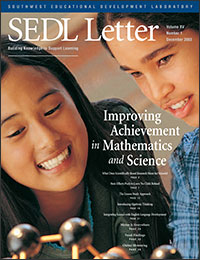Introduction: Changing Our Attitude toward Mathematics and Science to Improve Achievement
 Perhaps you have seen a similar headline: "Skilled Workforce Shortage Could Cripple U.S. Economy." It sounds serious—and it is, given the importance of mathematical and scientific skills in our increasingly technological society and the United States— lackluster performance on the Trends in International Mathematics and Science Study (TIMSS) and National Assessment of Educational Progress (NAEP) scores. While NAEP assessments overall show an improvement in mathematics achievement between 1990 and 1999, computation scores actually dropped during that time. In 1999, only about half of eighth and twelfth graders could compute accurately with fractions. NAEP scores also reflect an achievement gap—just 3 percent of Black students and 4 percent of Hispanic students reach the proficient level in mathematics by the 12th grade.
Perhaps you have seen a similar headline: "Skilled Workforce Shortage Could Cripple U.S. Economy." It sounds serious—and it is, given the importance of mathematical and scientific skills in our increasingly technological society and the United States— lackluster performance on the Trends in International Mathematics and Science Study (TIMSS) and National Assessment of Educational Progress (NAEP) scores. While NAEP assessments overall show an improvement in mathematics achievement between 1990 and 1999, computation scores actually dropped during that time. In 1999, only about half of eighth and twelfth graders could compute accurately with fractions. NAEP scores also reflect an achievement gap—just 3 percent of Black students and 4 percent of Hispanic students reach the proficient level in mathematics by the 12th grade.
In a way, we are all responsible for this poor performance. Robert Moses, in Radical Equations: Math Literacy and Civil Rights, observed that in our culture, "illiteracy in math is acceptable the way illiteracy in reading and writing is unacceptable. Failure is tolerated in math. . . . if you're struggling with an equation while doing your algebra homework, more likely your parent will look over your shoulder, wrinkle a brow in puzzlement, then say something like, 'I never got that stuff either.'"
It is time that all of us—educators, parents, and policymakers—begin to see mathematics as the enabling discipline for all of science and technology that it is and to recognize its power in providing tools for analytical thought and for concepts and language for quantitative descriptions of the world (RAND Mathematics Study Panel, 2002). We need to realize the importance of mathematics and science in the lives of all of our children, and make it possible for them to become proficient in mathematics and science.
How we do this, of course, is complex. It will mean changing the way we train teachers to teach math, requiring more than just a few courses in math for elementary education majors. And it will mean ensuring that qualified teachers are teaching math. One recent study found that more than half of our middle school mathematics teachers have neither a major nor a minor in mathematics! It also means building a strong research and development program in mathematics to find out more about effective teaching practices. At a February mathematics summit, Dr. Russ Whitehurst, director for the U.S. Department of Education's Institute of Education Sciences, acknowledged, "research in math is in its infancy compared, for example, to research on reading, and that what it provides for policy and practice is more in the way of educated guesses than strong direction."
Ensuring that all of our children become mathematically and scientifically proficient might also mean fundamental changes to the curriculum. When studying similarities and differences in eighth-grade mathematics among those nations that were high-performing on the TIMSS and the U.S., researchers found that in the U.S. many more mathematics topics are covered each year and we spend much more time reviewing material than is spent in other countries. Our curriculum continues to focus on basic computational skills through eighth grade and beyond. In the high-achieving countries, students in the middle grades had moved on to the study of algebra and geometry (Hiebert, et al., 2003).
Yes, we have a long way to go before all of our students can meet high standards in mathematics and science, but across the country, educators are changing how mathematics and science are taught. In this issue of SEDL Letter, we bring you two stories of how SEDL's Eisenhower Southwest Consortium for the Improvement of Mathematics and Science Teaching is helping to change teaching and learning are changing in the SEDL region. We also focus on two issues of importance to schools and districts—how No Child Left Behind will affect mathematics and science instruction and what scientifically based research means for schools and districts and why it matters. Rounding out this issue are articles examining how algebraic thinking can be integrated into the K–8 curriculum and how science can be effective in developing language skills in English language learners.
At SEDL, we hope your first semester has been a good one, and we wish you the best for the holiday season.
References
- Hiebert, J., et al. (2003). Teaching Mathematics in Seven Countries. Washington, DC: National Center for Education Statistics, U.S. Department of Education.
- Moses, R. P., & Cobb, C. E. (2001). Radical Equations: Math Literacy and Civil Rights. Boston: Beacon Press.
- RAND Mathematics Study Panel. (2003). Mathematical Proficiency for All Students: Toward a Strategic Research and Development Program in Mathematics Education. Santa Monica: RAND.
Next Article: What Does Scientifically Based Research Mean for Schools?

